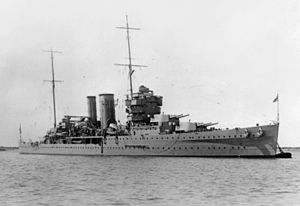
Back Йорк (тежък крайцер, 1928) Bulgarian HMS York (90) Catalan HMS York (90) Czech York (Schiff, 1930) German HMS York (90) Spanish اچاماس نیویورک (۹۰) Persian HMS York (90) Finnish HMS York (90) French HMS York (90) Italian ヨーク (重巡洋艦) Japanese
 York at anchor, 1930
| |
| History | |
|---|---|
| Name | York |
| Ordered | 21 October 1926 |
| Builder | Palmers Shipbuilding and Iron Company, Jarrow |
| Laid down | 16 May 1927 |
| Launched | 17 July 1928 |
| Commissioned | 1 May 1930 |
| Identification | Pennant number: 90 |
| Fate |
|
| General characteristics (as built) | |
| Class and type | York-class heavy cruiser |
| Displacement | |
| Length | 575 ft (175.3 m) |
| Beam | 57 ft (17.4 m) |
| Draught | 20 ft 3 in (6.2 m) |
| Installed power |
|
| Propulsion | 4 shafts, geared steam turbines |
| Speed | 32.25 knots (59.73 km/h; 37.11 mph) |
| Range | 10,000 nmi (19,000 km; 12,000 mi) at 14 knots (26 km/h; 16 mph) |
| Complement | 628 |
| Armament |
|
| Armour | |
HMS York was the lead ship of her class of two heavy cruisers built for the Royal Navy in the late 1920s. She mostly served on the North America and West Indies Station before World War II. Early in the war the ship escorted convoys in the Atlantic and participated in the Norwegian Campaign in 1940. York was transferred to the Mediterranean theatre in late 1940 where she escorted convoys and the larger ships of the Mediterranean Fleet. She was wrecked in an attack by Italian explosive motorboats of the 10th Flotilla MAS at Suda Bay, Crete, in March 1941. The ship's wreck was salvaged in 1952 and subsequently scrapped.